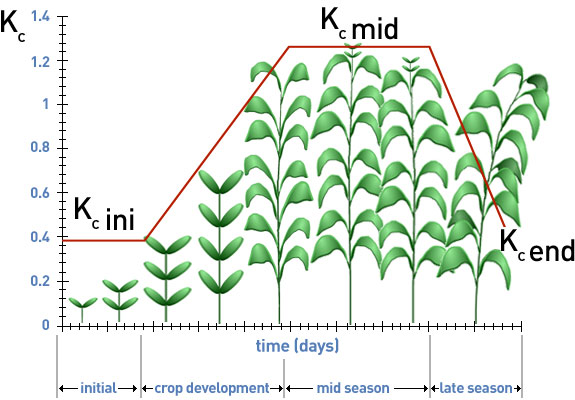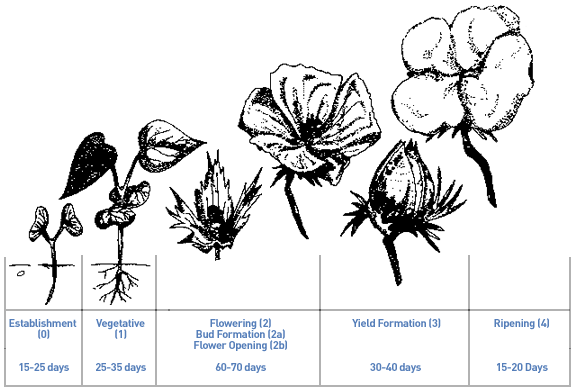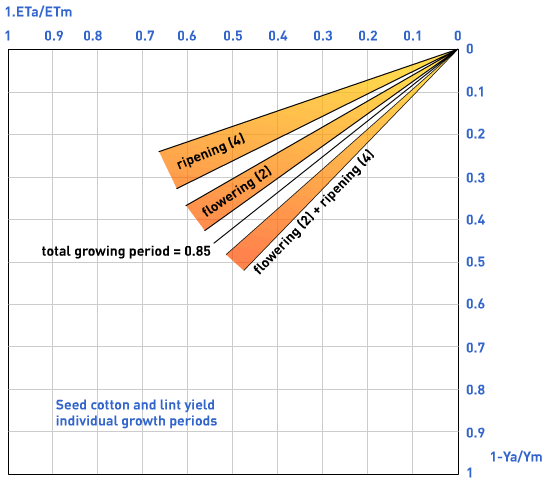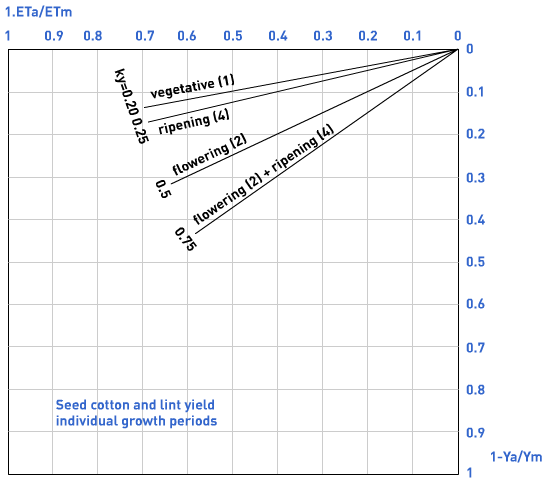Cotton (Gossypium hirsutum) is grown for fibre and seed. Present world production is about 21 million tons lint and 59.7 million tons seed cotton from about 33.98 million ha. (FAOSTAT, 2001). The origin of cotton is still uncertain. The development of the crop is sensitive to temperature. Cool nights and low daytime temperatures result in vegetative growth with few fruiting branches. The crop is very sensitive to frost and a minimum of 200 frost-free days is required. The length of the total growing period is about 150 to 180 days. Depending on temperature and variety, 50 to 85 days are required from planting to first bud formation, 25 to 30 days for flower formation and 50 to 60 days from flower opening to mature boll. No clear distinction can be made in crop growth periods since vegetative growth is continued during flowering and boll formation and flowering is continued during boll formation.
Cotton is a short-day plant but day-neutral varieties exist. However, the effect of daylength on flowering is influenced by temperature. Germination is optimum at temperatures of 18 to 30°C, with minimum of 14°C and maximum of 40°C. Delayed germination exposes seeds to fungus infections in the soil. For early vegetative growth, temperature must exceed 20°C with 30°C as desirable. For proper bud formation and flowering, daytime temperature should be higher than 20°C and night temperature higher than 12°C, but should not exceed 40 and 27°C respectively. Temperatures between 27 and 32°C are optimum for boll development and maturation but above 38°C yields are reduced.
Strong and/or cold winds seriously affect the delicate young seedlings and at maturity will blow away fibre from opened bolls and cause soiling of the fibre with dust.
Cotton is extensively grown under rainfed conditions. Although the crop is relatively resistant to short periods of waterlogging, heavy rainfall, however, can cause lodging. Continuous rain during flowering and boll opening will impair pollination and reduce fibre quality. Heavy rainfall during flowering causes flower buds and young bolls to fall.
Cotton is grown on a wide range of soils but medium and heavy textured, deep soils with good water holding characteristics are preferred. Acid or dense subsoils limit root penetration. The pH range is 5.5 to 8 with 7 to 8 regarded as optimum. The fertilizer requirements of cotton under irrigation are 100 to 180 kg/ha N, 20 to 60 kg/ha P and 50 to 80 kg/ha K. Two-thirds of the nutrients are taken up during the first 60 days of the growing period. Nitrogen should be readily available at the start of -the growing season; normally two applications are given with one after sowing and the other prior to flowering. Phosphate is applied before sowing. Plant spacing normally varies between 50/100 x 30/50 cm.
The crop is tolerant to soil salinity. Yield decreases at different ECe values are: 0% at ECe 7.7 mmhos/cm; 10% at 9.6, 25% at 13, 50% at 17 and 100°/ at ECe 27 mmhos / cm .
The graph below depicts the crop stages of cotto n, and the table summarises the main crop coefficients used for water management.

Stages of Development | Plant date | Region | |||||
|---|---|---|---|---|---|---|---|
Crop | Initial | Crop Development | Mid-season | Late | Total |
| |
Stage length, days | 30 | 50 | 60 | 55 | 195 | Mar-May | Egypt; Pakistan; Calif. |
Depletion Coefficient, p | 0.6 | >> | 0.6 | 0.9 | 0.65 |
| |
Root Depth, m | 0.3 | >> | >> | 1.4 | – |
| |
Crop Coefficient, | 0.35 | >> | 1.15-1.2 | 0.7-0.50 | – |
|
|
Yield Response Factor, Ky | 0.2 | 0.5 | – | 0.25 | 0.85 |
| |
Depending on climate and length of the total growing period, cotton needs some 700 to 1300 mm to meet its water requirements (ETm). In the early vegetative period, crop water requirements are low, or some 10 percent of total. They are high during the flowering period when leaf area is at its maximum, or some 50 to 60 percent of total. Later in the growing period the requirements decline. In relation to reference evapotranspiration (ETo) the crop coefficient (kc) for the different development stages is: for the initial stage 0.4-0.5 (20 to 30 days), the development stage 0.7-0.8 (40 to 50 days), the mid-season stage 1.05-1.25 (50 to 60 days), the late-season stage 0.8-0.9 (40 to 55 days), and at harvest 0.65-0. 7.
Following figure shows growth periods of cotton (after P.T. Walker)

The relationships between relative yield decrease (1 – Ya/Ym) and relative evapotranspiration deficit for the total growing period of cotton are shown in the figure below.

This figure shows the relationships between relative yield decrease (1 – Ya/Ym) and relative evapotranspiration deficit for the individual growth periods.

The crop growth periods for cotton are shown in Figure 14. The relationships between relative yield decrease and relative evapotranspiration deficit are shown in Figure 15. For calculation examples see p. 40 and Chapter V1.
Adequate water supply is needed for vigorous growth, good budding and fruiting and for the formation of healthy bolls. Excess water early in the growing period will restrict root and crop development. Cotton requires adequate water supply particularly just prior and during bud formation (2a). Continued water supply during flower opening (2b) and yield formation (3) periods results in prolonged and excessive growth and yield. Abrupt changes in water supply will adversely affect growth and cause flower and boll shedding. Severe water deficits during flowering may fully halt growth, but with subsequent water supply crop growth recovers and flower formation is resumed.
When the growing season is short such conditions lead to smaller yield. Water stress on cotton can be observed by discolouring of the stem and appearance of a bluish-green colour on the leaves.
Water supply for high production must be adjusted to the specific requirements of each growth period (see Scheduling). Optimum use of available water supply can be made by fully wetting the entire root zone up to 1.80 m at sowing and with subsequent wetting of the upper part (0. 50. to 1 m) of, the root zone only. Root activity may be increased’ and full utilization of the availble soil water over the entire root zone is made with little or no soil water left at the end of the growing season. Other savings can be made by utilizing the available water in the entire root depth by timely discon-tinuing irrigation applications at the end of the total growing period. Also savings can be achieved by withholding supply during the flowering period (2) until some 70 percent of the total available soil water has been taken up by the crop. A combination of the above practices may save up to 20 percent water without greatly impairing yields.
At sowing, adequate soil water should be available for germination and establishment (0). During the vegetative period (1), soil water content over the root depth of some 0.75 m should not fall below 50 percent depletion; greater depletion of available soil water (up to 75 percent) will restrict vegetative growth but when followed by ample supply, vegetative growth will be somewhat excessive, which may cause late flowering, boll shedding and reduced yield when the growing season is short. At flowering (2), supply will need to be scheduled to control vegetative growth in relation -to productive growth. Water deficits from onset of flowering to peak flowering may cause a more negative effect on yield as compared to when occurring after peak flowering. With severe water deficits during late flowering and early boll formation, boll shedding can be excessive. Moderate water deficit occurring during flowering (2) but high enough to restrict vegetative growth, will lead to good boll-set and higher yields, despite a reduction in number of flowers.
Adequate water supply should be available during the yield formation period (3). Depending on water holding capacity of the soil, development of the root system and evaporative demand, the water supply during the yield formation period (3) should be discontinued at a certain time before the ripening period (4). Excessive water supply during the yield formation period (3) may cause delay in boll opening and greater susceptibility to lodging and boll-rot. Under conditions of a long and warm growing season, an irrigation after the first harvest is sometimes practised to obtain a second yield. When water supply is limited, a higher total production is obtained by extending the area and partially meeting crop water requirements rather than by meeting full crop water requirements over a limited area.
From emergence to early flowering, the tap root may extend in deep soils to a depth of 1.8 m. During the flowering period, additional root development occurs in the upper part of the root zone. Frequent, light irrigation application during early growth periods tends to cause shallow root systems. As a rule, some 70 to 80 percent of the total water uptake by the crop occurs over the first 0.9 m depth, where more than 90 percent of the total root weight is found. Normally when the crop is fully grown, 100 percent of the water is extracted from the first 1.0 to 1.7 m soil depth (D = 1.0- 1.7 m). When water supply is terminated, water uptake will increasingly occur from lower soil depths but may not be sufficient during peak water requirement periods to maintain crop evapotranspiration and crop growth. Under conditions when ETm is 5 to 6 mm/day water uptake starts to be reduced when soil water depletion exceeds 65 percent (p = 0.65).
Cotton is grown under a great variety of irrigation systems of which furrow irrigation is the most common surface system. In regions where the demand for water is great and water resources are small, sprinkler and drip irrigation methods become more and more accepted to economize on water applied and restrict return flow of low quality. In the Near East region, cotton is also grown under controlled flood or spate irrigation, where with little or no rain a one-time pre-sowing irrigation of 0. 5 to 1 m depth stores sufficient water in the root zone to allow the crop to reach maturity. Under such treatments soils must be deep and have a high water holding capacity. With growing season from August to March with ETm = 700 to 750 mm and ETa = about 450 mm, farmers’ yields are about 800 kg/ha, with a maximum of about 1 700 kg/ha seed cotton.
A good yield of a 160 to 180 day cotton crop under irrigation is 4 to 5 ton/ha seed cotton of which 35 percent is lint. Water utilization efficiency for harvested yield (Ey) for seed cotton containing about 10 percent moisture is 0.4 to 0.6 kg/m3. Boll and fibre properties such as lint to seed ratio, and length, strength and fineness of lint, are primarily determined by the variety and to a lesser extent by irrigation and fertilizer practices. In general, the boll size, and the seed and lint index (weight per 100 seeds) increases under adequate water supply. However, the lint percentage (the ratio lint to seed) tends to decrease. Low soil water depletion levels during yield formation (3) tend to result in longer and finer fibre of decreased strength. The direct effect of water deficits on fibre properties, however, appears to be small because of the shedding of bolls which would have produced inferior fibre when allowed to mature.
Normally cotton seed contains 35 percent oil and 35 percent protein. Under irrigation there is an indication that severe water deficits substantially reduce the oil percentage in the seed, and more fibrous material with 20 percent lower oil and protein content is produced compared to an adequately irrigated crop.
